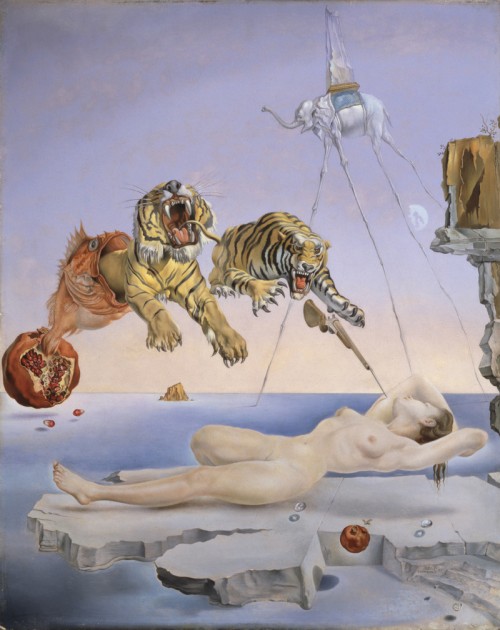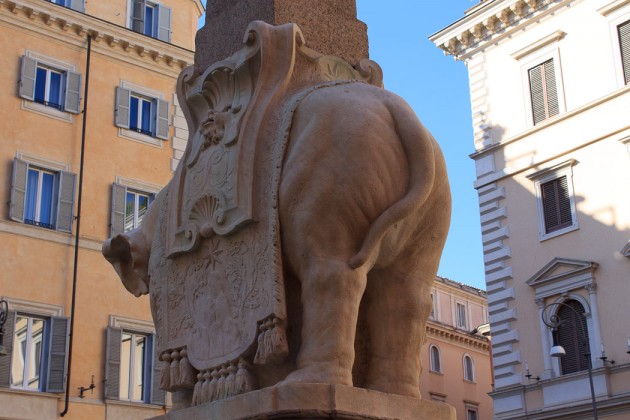Monday, March 21st, 2016
Bernini’s Elephant, Another Myth, and Dali

Bernini, elephant obelisk outside of Maria Sopra Minerva, 1667, Rome. Image via Wikipedia, courtesy of Petar Milošević
Of all of the sculptures created by Bernini, I think that the elephant carrying an obelisk is the most unexpected and bizarre. This monument has its own unusual history surrounding its creation and subsequent discussion in the 17th century, and then this monument ended up being incorporated into bizarre Surrealist imagery in the 20th century.
Originally, this monument was commissioned by Pope Alexander VII; its creation was really instigated by the 1665 discovery of the Egyptian obelisk within a garden of a Dominican monastery, and it was decided that the obelisk would be placed just outside the monastery itself. These facts are clearly documented. However, much of the following popular history surrounding the monument doesn’t have a historical foundation at all and seems more like another Bernini myth. According to this popular, although historically unsubstantiated, anecdote, the proposed designs for the monument allegedly included one by the monastery’s Dominican friars, Father Domenico Paglia; however, Alexander VII supposedly rejected this design and ultimately selected Bernini’s design of an elephant.1 According to the contemporary inscriptions written on the pedestal of the monument, the elephant was selected as a symbol of strength, and the obelisk was surmounted on top was to serve as a symbol of holy knowledge or divine wisdom.2 (The symbolism of the obelisk as Divine Wisdom is a little ironic, considering that this obelisk originally held a political – and non-Christian – context, since it was created by the Pharaoh Apries, who reigned 588-569 BCE).3
This anecdote continues by mentioning alleged controversy surrounding the construction of the monument. Father Paglia apparently didn’t like Bernini’s design, and thought that the obelisk would be unstable without more supporting weight underneath the elephant. Bernini refused to change his design (as seen in his bozzetto model), but later allegedly was forced to do so (although he tried to add a saddlecloth to hide the supporting weight placed underneath the elephant). According to this story, Bernini may have made a final retaliating remark to Paglia with the way that he positioned the elephant: the rear of the animal is pointed toward the direction of the Dominican father’s office. Furthermore, the tail of the animal is slightly raised, suggesting that Bernini’s elephant is defecating (since the muscles look more tense) and/or saluting Paglia in an obscene way.4 (Although this story is unsubstantiated, one can note that that Bernini’s design, especially with the raised tail, is a unique departure from Bernini’s visual inspiration for this project: an image from a fifteenth-century novel Hypnerotomachia Poliphili, which shows the elephant with a lowered, not raised, tail).
It is interesting to me that this anecdote has held such popularity over the years (with origins going back to the 17th century), even though there isn’t a historical document to support this story about Paglia and Bernini.5 (I really appreciate that someone on Wikipedia is trying to set the story straight through a lengthy footnote.) In some ways, the story reminds me a bit of the myth that I mentioned in a previous post, in which Bernini’s sculpted figure of Rio de la Plata is shielding its gaze from Borromini’s church Sant’Agnese.
Regardless of the historical circumstances surrounding the creation of the elephant, it has captured the attention and admiration of many people over time. (Today, the elephant is affectionately known by the nickname “Minerva’s Chick” (“Pulcino della Minerva”) which is due to a mispronunciation of an earlier nickname “Minerva’s Piggy” (“Porcino della Minerva”), that alluded to the stout body of the elephant.) The Surrealist Salvador Dali was apparently inspired by the imagery of an elephant carrying an obelisk on its back, and utilized that motif in Dream Caused by the Flight of a Bee Around a Pomegranate a Second Before Awakening (1944) and The Temptation of Saint Anthony (1946).

Salvador Dali, “Dream Caused by the Flight of a Bee Around a Pomegranate a Second Before Awakening,” 1944.
I haven’t found any written information about Dali mentioning his interest in Bernini’s monument or in Bernini in general (if you know of anything, please share). But, given the context of Dali’s interest in dream-like imagery and the might-as-well-be-a-dream anecdote surrounding Bernini’s own monument, I think the elephants in these paintings are pretty appropriate.
1 Guiseppe Paglia was the historically-documented director for this project outside Santa Maria Sopra Minerva. Pergola’s alleged designs for the monument are mentioned in great detail in this popular anecdote, explaining that his monument would have included the six Chigi mountains (part of Alexander VII’s family crest). However, no historical sources describe this design. It is important to note that Alexander VII makes no mention of Paglia’s design in his journal. See Katie Blake, p. 8.
2 On the side of the monument facing east includes an inscription (translated into English): “Let every beholder of the images, engraven by the wise Egyptian and carried by the elephant – the strongest of beasts – reflect this lesson: Be of strong mind, uphold solid Wisdom.” The side of the monument facing west includes this inscription (translated into English): “In the year of Salvation 1667, Alexander VII dedicated to Divine Wisdom this ancient Egyptian obelisk, a monument of Egyptian Pallas, torn from the earth and erected in what was formerly the forum of Minerva, and is now that of the Virgin who gave birth to God.” See Katie Blake, The Elephant and the Obelisk essay, p. 7.
3 For a detailed discussion of the obelisk as a symbol of Holy Wisdom, see Blake, p. 8-9.
4 For more information regarding this anecdote, see Blake, p. 8-9.
5 It seems this anecdote originated at the end of the 17th century, when Cardinal Lodovico Sergardi, a satirist, circulated a two-line epigram. Therein, he elephant tells the Dominicans that the position of his rear end conveys “where I hold you in my esteem.” See Ingrid Rowland, ‘The Friendship of Alexander VII and Athanasius Kircher, 1637-1667’ in Early Modern Rome: Proceedings of a Conference Held on May 13–15, 2010 in Rome, ed. Portia Prebys [Ferrara: Edisai, 2011], pp. 669-78.


I wasn’t aware of any of this. Super interesting!
Thanks. I remember stumbling upon the elephant while strolling around Rome some years ago. I like that there’s a Dali connection.
Ben Harvey wrote via Twitter:
1. I was interested and a bit surprised to see Rome represented as a war elephant in the floor of Siena cathedral. I wonder whether Bernini’s monument may also be a reference to Rome and its war elephants (appropriated from Hannibal?). The etymology of the word Rome is sometimes connected to notions of strength, which would fit rather well with an obelisk bearing elephant. I’m also struck by the imperialist nature of the imagery: Egyptian spolia and an African (or Indian?) elephant. Plus memories of Hannibal. Rome’s past glory and conquests?
#2. Not sure about Dali and Bernini, but Surrealists would be predisposed to like a monument that “foreshadows” their obsession with unlikely combinations or “dislocations” (e.g. a telephone and a lobster, or Lautreamont’s sewing-machine and an umbrella). Apologies for rambling on like this!
My response: Hi Ben! Thank you for comment. I think that your connection between the elephant and Hannibal is especially interesting to consider: even though this was originally intended for a monastery garden, the object ultimately was put on public display since it was decided to be placed outside. Furthermore, this connection with past triumphs serves as a reminder of political strength (and therefore also has an interesting parallel with the power struggle between Father Paglia and Bernini over the monument design). I think Bernini was probably especially offended that Father Paglia didn’t think the monument design appeared to be stable, since this project post-dates Bernini’s failed attempt to create stable bell towers for Saint Peter’s in the 1640s.
That’s a great connection with Surrealist “dislocations” too! Maybe someone should pay homage to that and design an elephant-and-obelisk telephone!
Also, via Twitter Ben shared a detail image of the Siena Cathedral floor, which has Rome depicted as an elephant carrying a fortress. Ben explained: “Siena cathedral floor… (Siena took Romulus and Remus for itself so had to find a different symbol for Rome!).” Here is an image of the entire floor; Roma is represented on the left.